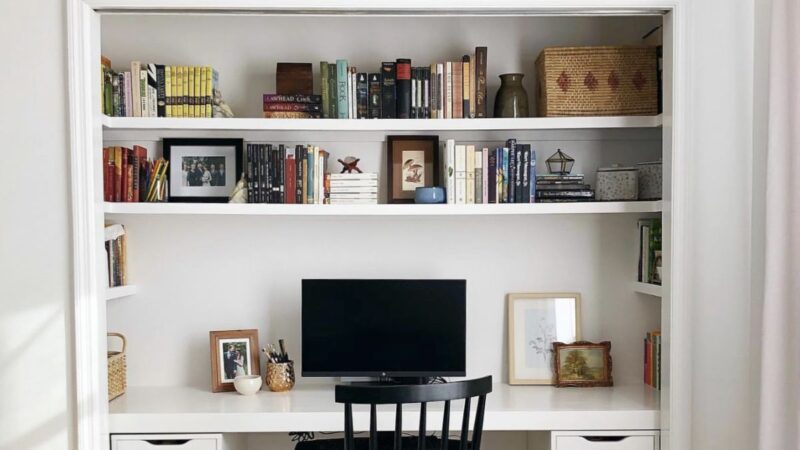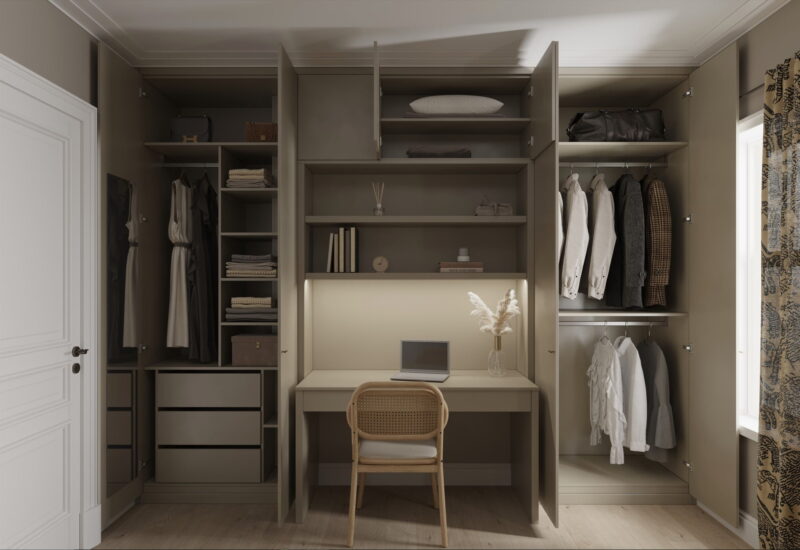Working from home or in a hybrid setting takes its toll as time goes by. Back in 2020, many were happy with the opportunity to finally work from home, without having to wake up early and deal with public transport until they get to the office. Working from your couch or dining table is an option, but it’s not convenient as a desk and anatomic chair, especially for full-time employees.
That’s why people today are looking for some creative and convenient solutions to create a functional home office. Cloffice, or a closet turned into an office, is a great way to maximize the space, especially in smaller apartments. Companies like Domaine Furnishings & Design are already taking advantage of it, offering compact and practical furniture for everyone who wants a closet home office.
If you’re into it, let’s see how to get the most out of this project:
1. Measure the Dimensions

Before starting anything, measure the available space. That way, you know how much space you have available for the desk, chair, and some drawers or shelves. Dimensions make the project easily manageable because you won’t have to deal with challenges regarding size and space availability.
2. Closet Accessibility
Not every closet can be turned into a home office. There are plenty of factors to consider, like how the doors open and whether it offers enough space to have a comfortable working day, with enough daylight available. Sometimes, you’ll have to replace the folding doors with sliding ones or even with curtains to save space and make it practical. Remember, sometimes, you won’t be able to make this project come true without significant adjustments (that may be too costly to consider.)
3. Decide About the Work Surface

Having a desk must be a top priority for you. Floating desks save plenty of space, giving you an option to add mobile drawers and install additional shelves for your office supplies. Consider a foldable desk so you can easily store it once you’re done with the work for the day.
4. Comfortable Seating
Your terrace or dining chairs don’t provide enough support and cushioning to your body, to spend eight ours on them. While the couch seems like a fair alternative, we suggest investing in a quality chair, especially if you know you won’t get back to the office for longer. Depending on space, a small ergonomic chair or even a kneeling chair can work well.
5. Available Storage
Some closets or cabinets have enough space to put the clutter away and work in a tidy environment. If not, you should consider installing additional shelves and storage cabinets, so you can have a neat surrounding and work with no distractions at all.
6. Lighting and Power

Some closets are dark, and you will need additional lighting to work consistently. You can use desk lamps or install LED strips above the desk, so you won’t have to work in the dark. Additional power outlets are a must, especially if you’re using more devices than a simple laptop. Ensure the power is properly installed to avoid some outage risks.
7. Personalize Your Cloffice
Since this is your office now, feel free to add a board or rug or even paint some of the walls in a preferred color. The more you personalize your space, the easier it gets to get used to it. Ultimately, you’ll be able to be productive the same way as in a corporate office.
8. Create a Hidden Workstation
Closets give you an opportunity to create a hidden workstation to avoid distractions. Also, you can close the closet doors and no one will ever know about your safe place. At the end of the day, you’ll feel comfortable and relaxed without having to look at your usual workstation and the clutter it brings.
9. Provide Ventilation

Use a portable ventilator to ensure air movement. The trapped heat can make you sweaty, nervous, and less productive. Ensure there is always some airflow around you to avoid the described scenario. The lack of ventilation is the main disadvantage of closet home offices, but we’re sure you can manage this thing perfectly and still consider this option convenient enough for your daily work tasks.
Potential Cloffice Drawbacks
While the initial idea seems perfect, there are some potential drawbacks to consider. Some people may find the closets extremely small, making them feel claustrophobic. Poor ventilation can be another reason to set the dining table instead of the closet desk.
Natural light is essential to keep us productive. The lack of daylight requires artificial lighting, which is not the best option for some workers. The closet location is important, too. Sometimes, the closets are too close to the noisy parts of the house or neighborhood, which is not the best option for those who have many tasks to complete during the day.
Closets also trap heat, making it too warm to work, especially during summer. And finally, it makes video calls difficult. The limited space and unusual background can be a problem, especially if you have too many meetings during the day.
How To Ensure You’re Making the Right Choice?
While there are so many factors to consider, there are a few ways to check if the office is the best choice for you: Easy access to WiFi, electricity, and daylight. All these factors make working comfortable and convenient. In any other scenario, the office is not the best choice.
We all want to be practical and enhance the living space. Using closets as a home office is a great idea for those who don’t need them for storage or have a spare closet in some distant room. We suggest you think twice before committing to such a project, as it may take plenty of time and money without providing it to you.
Finally, there are many corners of the home that make a perfect home office. Ensure you have enough daylight to keep you productive, and even change locations to make the working process smoother and more convenient.

